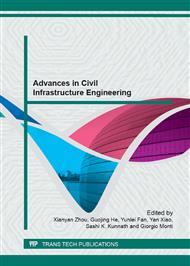p.957
p.961
p.965
p.969
p.974
p.978
p.985
p.992
p.998
Study on Stability of Highway Subgrade Slope in Desert Region
Abstract:
With the rapid development of economy, highway infrastructure is gradually extended to desert region. But at present, affected by the special engineering geological environment in desert areas, the work must be majorly planned and considered before the highway project is set that how to reduce the construction cost while ensuring the desert highway construction quality, and maximizing the maintainance and further improvement of desert environment. The wind and sand environment characteristic of desert areas is analyzed in this paper, then the common types of desert highway subgrade slope are investigated and the stability of wind-blown sand subgrade slope is studied, finally the theories and methods according to the characteristics of the desert subgrade are proposed.
Info:
Periodical:
Pages:
974-977
Citation:
Online since:
January 2013
Authors:
Keywords:
Price:
Сopyright:
© 2013 Trans Tech Publications Ltd. All Rights Reserved
Share:
Citation:


